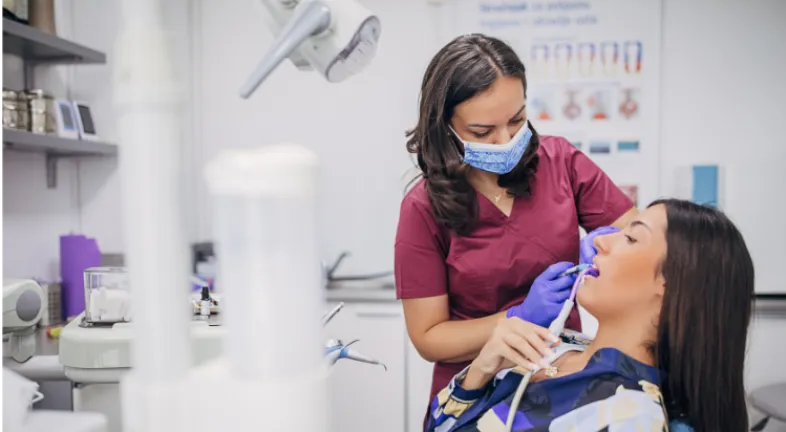
Correcting crooked, misaligned teeth is essential for your dental health, general health, appearance, and self-esteem. Braces are the most common dental appliance used to straighten teeth and achieve the perfect smile. They’re available in different types and designs, but all have the same goal of moving teeth back into their correct positions.
The two principal types of braces are fixed braces and removable braces, and there are significant differences between them. For example, the price of treatment. Fixed braces can be more expensive than removable ones. You may think you can save money by having your teeth straightened on the NHS, but in general, no-cost orthodontic treatment is only provided to people under the age of 18.
In this handy guide, we’re going to look at some of the different types of adult braces you can choose from and explain why removable braces come out as clear favourites.
Fixed Braces
Despite their cost and appearance, fixed braces are still the most popular teeth-straightening solution worldwide. There are several different kinds, and they function similarly. As the name suggests, fixed braces are fixed to the teeth by a dentist or orthodontist.
Typically, they consist of square brackets fixed to each tooth with a special dental cement. A wire (called the archwire) is threaded through each bracket, joining them together. The function of the wire is to pull misaligned teeth into position over time. Generally, the wires are attached to brackets with an elastic band known as a ligature.
Treatment time is usually one to two years but can take longer depending on your individual needs.
Metal Braces
Metal braces are the most commonly used teeth straightening method and are usually made of high-grade stainless steel, although they can also be made from titanium. In terms of cost, they are also the cheapest. Metal braces are widely known as “train tracks” and are what most people think of when they hear the word “braces.”
One of the most significant downsides to this type of adult brace is they’re noticeable, especially when you smile, talk and laugh. This often makes people feel very self-conscious, especially when socialising with others or at work. As a result, some metal brace wearers restrict their social activities because they’re embarrassed about having bits of metal stuck to their teeth. Others will keep up with their everyday social lives but smile or talk less because of concerns about their self-image.
How long the braces take to work depends on how severe your orthodontic case is. If you have mild problems, you may only need to wear them for around six months. In some cases, you may have to wear them for two years or more if the problem is moderate to severe. During treatment, you will need regular appointments with your dentist/orthodontist to check progress and have your braces adjusted.
Ceramic Braces
Ceramic braces are essentially the same as traditional metal braces, except they’re made from a transparent or tooth-coloured ceramic material. Although they’re not invisible, they blend in better with a person’s teeth. The clear or tooth-coloured brackets are glued to the front surfaces of teeth and straightened in the same way as metal braces, with an archwire and rubber bands.
People who opt for ceramic braces often feel less self-conscious about wearing them. However, they tend to move teeth slower than metal braces, so they have to be worn for longer. Treatment length is generally between one and three years.
Lingual Braces
Lingual braces (or incognito braces) are small metal squares fitted behind the teeth where the tongue rests, meaning they go unnoticed by the casual observer. It’s as if they’re invisible, which avoids social embarrassment. Consequently, people with lingual braces tend not to restrict their social activities for fear of embarrassment. Only if you open your mouth very wide will someone else be able to see them.
These types of adult braces work in the same way as fixed metal braces, but the metal (or ceramic) brackets are attached to the inner surface of the teeth. They use a similar wire and bracket system, applying gentle and continuous pressure to misaligned or crooked teeth to move them into their desired position.
Treatment length can vary. It can take as little as six months to correct mild overcrowding and as much as 18 months to correct crooked or overcrowded teeth.
Self-Ligating Braces
Just like traditional metal braces, self-ligating braces consist of metal brackets attached to the outside of your teeth and wire. However, spring-loaded clips hold this archwire in place, not elastic bands. The system uses less pressure to straighten teeth, and treatment time can be slightly shorter than that of metal braces, usually 6 to 24 months, depending on the complexity of the problem.
As with other types of fixed adult braces, self-ligating braces are probably not a good option for appearance-conscious patients. With brackets and wires made of metal, they are very noticeable. Clear or ceramic braces are also available and, although they’re slightly less prominent, are still visible. They are also more expensive.
Removable Braces
Removable braces or clear aligners offer a more convenient solution than traditional fixed braces. These transparent removable orthodontic devices are clear plastic trays customised to fit an individual’s teeth. They’re worn daily and apply gentle pressure to help guide teeth into their correct position. Being made of clear, strong plastic, they are nearly invisible and therefore do not affect a wearer’s work or social life.
The key advantages of clear aligners are:
The invisible alternative to traditional adult braces
If you’re concerned about your crooked teeth and worried about the expense of traditional braces and how they will change your appearance, consider clear aligners from direct-to-consumer brands like Caspersmile which provide an affordable treatment delivered right to your doorstep.
Curated the best for your knowledge
.webp) Tooth Resorption: Causes, Symptoms, and Treatment Options
Tooth Resorption: Causes, Symptoms, and Treatment OptionsTooth resorption often goes unnoticed until real damage appears. Many people discover it during a routine dental visit and feel a wave of fear, wondering how such a hidden process could silently weaken their smile. The truth is that tooth resorption is more common than most expect, and early detection can make all the difference. By understanding why it happens, how it progresses, and which treatments actually work, you can protect your teeth with confidence. You don’t have to feel overwhelmed. When you know what to look for, you stay one step ahead and safeguard your long-term oral health.
Read More Teeth Troubles Explained: Causes, Symptoms & Fixes
Teeth Troubles Explained: Causes, Symptoms & Fixes Teeth problems happen when we take our pearly whites for granted. When our smile is nice and healthy, we don’t think much about it. And the moment things go south, we panic. Saving, or remaking, that smile becomes a priority. For some, though, the issues are present right from the start. Misalignment, bite issues, and teeth troubles that are more “structural” in nature. They don’t happen due to neglect; rather, they are given by luck, God, nature, whatever you believe in. That being said, no matter the type of tooth trouble, there’s a solution out there. And we’re exploring all that today, teeth diseases and treatment, one by one.
Read More Odontomas: What They Are and How They're Treated
Odontomas: What They Are and How They're TreatedSome dental conditions are quiet. Too quiet, in fact. Odontomas fall into that category. They rarely make noise, yet they change things beneath the surface. And people usually have no idea about them. While malocclusions, teeth shifting, discoloration, or other cosmetic dental issues are fairly well known, odontomas are not. So, an odontoma is technically a type of tooth tumor. It’s benign, harmless, but oddly structured. Hence, it can interfere with tooth eruption, displace teeth, or cause swelling. However, there’s more to it. Here’s a deeper dive.
Read MoreQuick Links

Heading